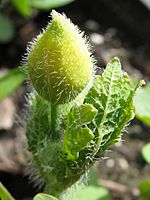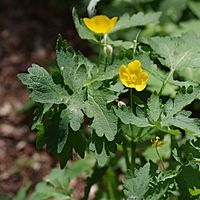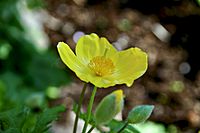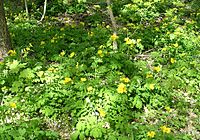Woodland poppy facts for kids
Quick facts for kids Woodland poppy |
|
|---|---|
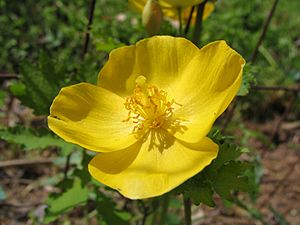 |
|
| Conservation status | |
| Scientific classification | |
| Genus: |
Stylophorum
|
| Species: |
diphyllum
|
The Woodland poppy, also called celandine-poppy or woods-poppy, is a beautiful wild flower. It's an herbaceous plant, which means it has soft stems, not woody ones like trees. This bright yellow plant is part of the poppy family (Papaveraceae). You can find it growing naturally in the eastern United States and in Ontario, Canada. It loves moist forests, especially in places with limestone rocks and deep ravines. Sometimes, people even grow it in their gardens because of its cheerful yellow flowers. Its common name, "celandine-poppy," comes from a similar European plant called greater celandine.
Contents
What Does the Woodland Poppy Look Like?
The Woodland poppy is a perennial plant, meaning it lives for more than two years. It grows from underground stems called rhizomes and can reach about 1.5 feet (45 cm) tall. Its leaves are deeply cut and lobed, almost like they've been divided into smaller parts. They grow from the base of the plant and also in a pair at the top of the flowering stems. If you break a stem, you might see a yellow-orange latex (a milky sap) that can stain.
Its Bright Yellow Flowers
In spring, the deep yellow flowers of the celandine poppy create a brilliant display on the forest floor. Each flower has four yellow petals. It also has two sepals that fall off quickly, many yellow-orange stamens (which produce pollen), and one knobby stigma (which receives pollen). The flowers appear one by one or in small groups of two to four. They bloom from early spring to early summer, growing from between a pair of leaves at the top of the stems. These flowers produce pollen but no nectar.
Seeds and Pods
After the flowers are pollinated, a bristly, blue-green pod forms and hangs below the leaves. Inside, the seeds have small, white attachments called elaiosomes. These seeds ripen in midsummer, and then the pod opens by four flaps to release them.
- Life stages
How Does the Woodland Poppy Reproduce?
You can grow new Woodland poppies from seeds or by carefully dividing existing plants in the spring. This plant grows best in moist soil that is rich in humus (decayed plant matter). It also prefers to grow in the shade. If you divide the plants, it's best to do it early in the morning, especially on a cloudy and mild day. Woodland poppies can live for a long time and often plant their own seeds in gardens, creating new plants naturally.
Conservation Status
The Woodland poppy is a special plant that is not very common across its natural range. Losing forests is one reason why some groups of these plants have disappeared. The wood poppy needs partly shaded conditions to grow well. Even cutting down only some trees can harm it by letting too much sunlight reach the forest floor. Because it doesn't grow in many places in Canada, the Woodland poppy is protected under Ontario's Endangered Species Act, 2007. This law helps protect both the plant and its home. One group of wood poppies in Ontario lives in a special conservation area.



